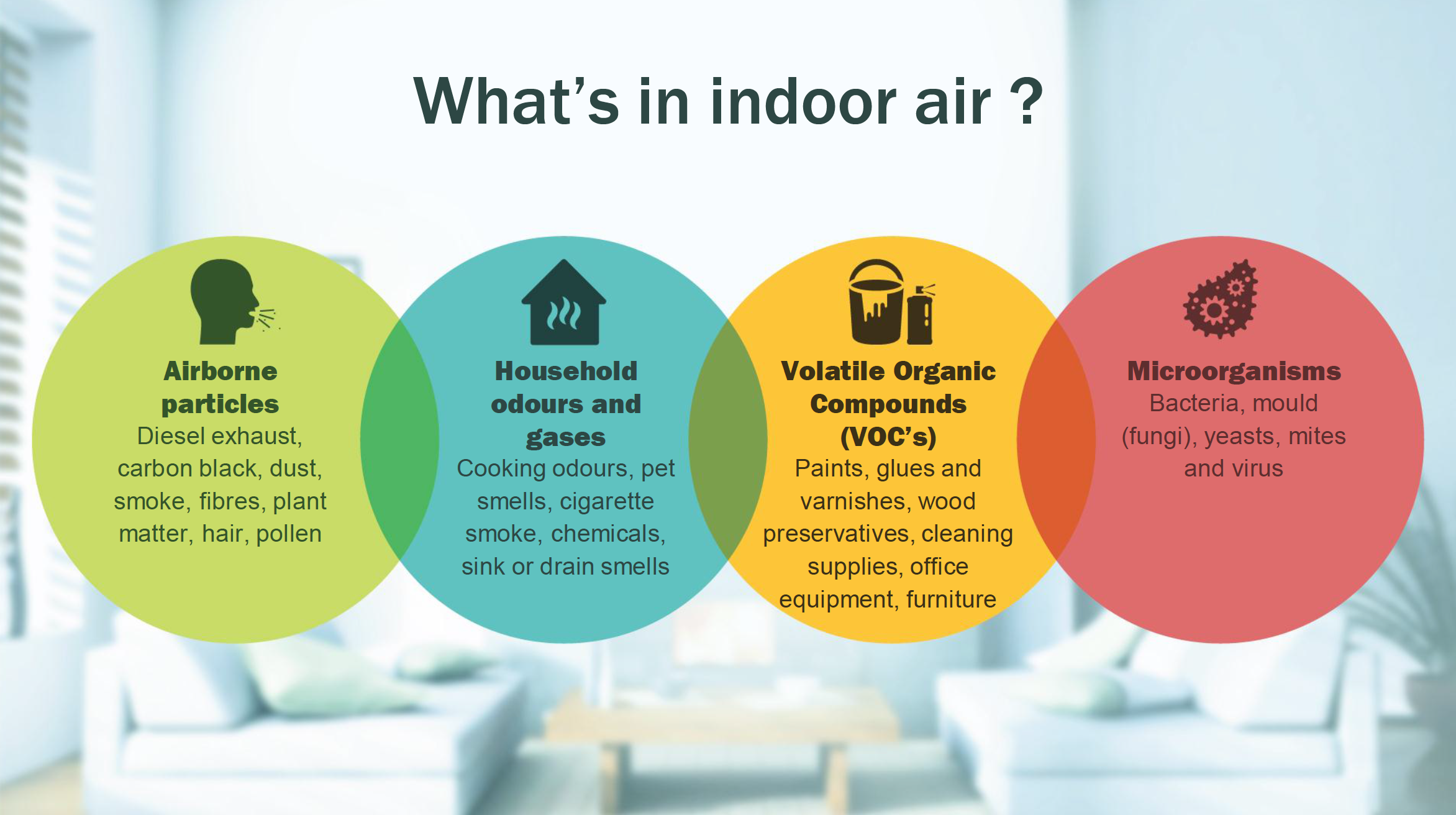Indoor air quality is a crucial factor that plays a significant role in our overall health and well-being. Poor indoor air quality can lead to various health effects, including respiratory problems, fatigue, and decreased cognitive function. With many of us spending upwards of 90% of our lives indoors, the importance of addressing indoor air pollution cannot be overstated. To improve indoor air quality, implementing strategies such as better ventilation and utilizing air purifiers can make a notable difference in our living and working environments. By understanding the relationship between the indoor environment and health, we can create healthy building designs that support our wellness and productivity.
The condition of the air we breathe within our homes and workplaces significantly influences our health and daily performance. Known as the indoor environment, this space can harbor pollutants that adversely affect our physical and mental well-being. Improving air conditions is essential for cultivating a healthier lifestyle, especially given that we spend so much time indoors. Design choices focused on wellness can help mitigate the negative impacts of indoor air contamination. By recognizing these factors, we can foster environments that contribute to our overall quality of life.
Understanding Indoor Air Quality
Indoor air quality (IAQ) refers to the air quality within buildings, especially as it relates to the health and comfort of building occupants. Poor indoor air quality can lead to a range of health issues, including respiratory problems, headaches, fatigue, and even long-term illnesses. The significance of IAQ is particularly pressing as people spend up to 90% of their time indoors. Addressing this issue involves understanding sources of indoor air pollution, such as volatile organic compounds (VOCs), mold, and inadequate ventilation, which can significantly impact the overall health of individuals in these environments.
Improving indoor air quality is not just about eliminating pollutants; it also involves utilizing building materials and design features that contribute to healthier spaces. Healthy building design emphasizes natural ventilation, the use of non-toxic materials, and air purification technologies, all of which can enhance the indoor environment and health of occupants. By paying attention to these factors, we can create spaces that not only promote better health outcomes but also enhance productivity and well-being.
Health Effects of Indoor Air Pollution
Indoor air pollution is a critical concern that can have profound health effects, particularly for vulnerable populations such as children, the elderly, and those with pre-existing health conditions. Pollutants like carbon monoxide, particulate matter, and biological contaminants can exacerbate asthma, allergies, and other respiratory ailments. Harvard studies have shown a direct correlation between high levels of indoor air pollution and decreased cognitive function, illustrating that the air we breathe indoors can impact not just our physical health but cognitive performance as well.
The health effects of indoor air pollution extend beyond immediate symptoms. Long-term exposure to poor indoor air quality can lead to serious health complications, including cardiovascular disease and chronic obstructive pulmonary disease (COPD). By implementing strategies to improve indoor air quality, such as increasing ventilation rates and incorporating air-filtration systems, we can mitigate these health risks significantly. These measures are crucial to fostering a healthy indoor environment that supports long-term health and well-being.
How to Improve Indoor Air Quality
Improving indoor air quality encompasses a variety of strategies designed to reduce exposure to harmful pollutants and enhance overall environmental health. Simple steps can make a big difference, such as regularly changing HVAC filters, utilizing air purifiers with HEPA filters, and ensuring adequate ventilation. Additionally, incorporating plants into indoor spaces has been shown to improve air quality by absorbing toxins and releasing oxygen. These small changes can lead to notable improvements in health outcomes for building occupants.
Moreover, more comprehensive approaches to improve indoor air quality can include the redesign of spaces to incorporate healthier materials that emit fewer pollutants. Healthy building design principles advocate for the selection of low-VOC paints, non-toxic flooring, and sustainably sourced furnishings. By prioritizing these materials during construction and renovation processes, we can create environments that support better air quality and, consequently, better health for everyone who occupies these spaces.
The Connection Between Indoor Environment and Health
The relationship between the indoor environment and health is increasingly being recognized by public health researchers. Studies reveal that the quality of the air we breathe indoors can significantly influence our physical and mental health. Poor indoor air quality has been linked to an increased risk of respiratory illnesses, allergies, and even conditions like depression and anxiety. Understanding this connection emphasizes the need for a holistic approach to building design and management that prioritizes occupant health.
Furthermore, by creating a healthy indoor environment, we can enhance overall well-being and reduce healthcare costs related to pollution-induced illnesses. Sustainable practices in architecture and urban planning can play a critical role in developing spaces that foster health. By focusing on functional and aesthetic aspects that align with healthy building design, we can create environments where people not only survive but thrive.
Building Design for Enhanced Indoor Air Quality
Healthy building design is a comprehensive approach that integrates architecture, engineering, and public health with the aim of creating environments that optimize indoor air quality. This design philosophy prioritizes natural light, open spaces, and the strategic placement of windows to maximize fresh air flow while minimizing pollutants. Additionally, using materials that are both aesthetically pleasing and environmentally responsible not only enhances indoor air quality but also promotes the overall health of occupants.
Involving health experts in the planning and design process can lead to the development of spaces that actively improve indoor air quality. For instance, using advanced ventilation systems that monitor and adjust air quality in real-time can dramatically reduce indoor air pollutants. Such innovations not only contribute to healthier environments but also heighten occupants’ awareness of their surroundings, fostering a culture of health consciousness in workplaces and homes.
Quiz: Assess Your Indoor Air Quality Knowledge
Engaging with the topic of indoor air quality via quizzes can be an effective way to raise awareness and foster understanding of this critical issue. A quiz tailored to explore knowledge around indoor air pollution sources, health effects, and improvement strategies can empower individuals to take action in their own environments. By assessing how much they truly know about indoor air quality, participants can identify gaps in their understanding and further educate themselves on the steps necessary to improve their indoor environments.
These quizzes serve not only to inform but also to encourage proactive measures to ensure better indoor air quality. Utilizing resources and educational materials, participants can learn about the direct impact their choices can have on their health and the environment. This interactive approach complements traditional learning methods by creating a dynamic platform for discussion and personal reflection on indoor air quality awareness.
Ventilation and Its Importance for Indoor Air Quality
Ventilation plays a crucial role in maintaining acceptable indoor air quality by diluting indoor pollutants and increasing the supply of fresh outdoor air. It is essential for reducing concentrations of airborne contaminants such as dust, smoke, and chemicals. Moreover, proper ventilation can help control humidity levels, which, in turn, minimizes the chances of mold growth and other allergenic biological contaminants that can negatively impact health.
Incorporating effective ventilation systems in building design is vital for creating healthier living and working environments. This includes both natural ventilation, such as strategically placed windows to encourage airflow, and mechanical systems that ensure a continuous supply of fresh air. As research continues to illustrate the correlation between ventilation rates and cognitive performance, it becomes clear that prioritizing airflow in building designs is not only beneficial for comfort but essential for health.
Identifying Indoor Air Pollutants
Identifying sources of indoor air pollutants is a crucial first step in improving indoor air quality. Common culprits include household cleaning products, personal care items, and building materials that emit volatile organic compounds (VOCs). Additionally, biological contaminants such as mold, dust mites, and pet dander can compromise air quality. Understanding what these pollutants are and where they come from allows us to take proactive measures in minimizing their impact on our health.
Effective strategies for identifying and addressing indoor air pollutants include regular monitoring and testing of air quality levels, professional inspections, and adopting cleaner, greener products. By becoming informed about indoor air pollution and its sources, individuals can make better choices when selecting products and improve their home or workplace’s overall air quality. This knowledge empowers people to create healthier environments for themselves and their families.
The Future of Indoor Air Quality Management
The future of indoor air quality management hinges on advancing technology and greater awareness of environmental health. Innovations in building materials and air purification technologies are paving the way for healthier indoor environments. For instance, smart sensors that can detect pollutants and automatically adjust ventilation levels in real time are becoming increasingly popular. These advancements promise not only to provide immediate benefits but also to foster long-term health and well-being.
As understanding around the significance of indoor air quality continues to grow, so too will the focus on creating policies and guidelines that support healthier environments. Governments, organizations, and individuals alike will play essential roles in promoting standards for indoor air quality that prioritize health. With collective action and informed decision-making, we can ensure the future of our indoor environments supports not just productivity but also a high quality of life.
Frequently Asked Questions
What are the health effects of indoor air pollution?
Indoor air pollution can significantly impact health, leading to issues like respiratory problems, headaches, fatigue, and decreased cognitive function. Prolonged exposure can exacerbate existing health conditions like asthma and allergies.
How can I improve indoor air quality in my home?
To improve indoor air quality, consider using air purifiers with HEPA filters, ensuring proper ventilation by opening windows, regularly changing HVAC filters, and minimizing the use of volatile organic compound (VOC) products.
What factors contribute to indoor air quality in healthy building design?
Healthy building design emphasizes good ventilation, the use of non-toxic materials, and adequate control of humidity levels to promote better indoor air quality. This helps create environments that enhance occupant health and well-being.
How do indoor environments affect health and productivity?
Poor indoor environments can lead to reduced productivity and health issues. Good indoor air quality is linked to better concentration, energy levels, and overall cognitive function, according to research by Harvard experts.
What can I do to reduce indoor air pollution in my workplace?
To reduce indoor air pollution in the workplace, increase air ventilation, utilize air filtration systems, implement regular cleaning protocols, and encourage employees to minimize the use of chemical products.
What role does ventilation play in maintaining indoor air quality?
Ventilation is crucial for maintaining indoor air quality as it helps dilute indoor pollutants and bring in fresh air, thereby reducing the concentration of harmful airborne contaminants.
How can ventilation rates impact cognitive function and health?
Studies indicate that higher ventilation rates can improve cognitive function and reduce health complaints among occupants, making it essential for workplaces to ensure adequate airflow.
Is dust harmful to indoor air quality and health?
Yes, dust can harbor allergens, bacteria, and even chemical contaminants, which may provoke allergic reactions and respiratory issues, thus negatively affecting indoor air quality.
How can outdoor air quality affect indoor air environment?
Outdoor air quality can impact indoor environments, especially in apartments or buildings with shared ventilation systems, allowing pollutants from the outside to infiltrate the indoor air.
What types of air cleaners are effective for improving indoor air quality?
Air cleaners equipped with HEPA filters are effective in removing airborne particles, allergens, and some pathogens, thereby improving indoor air quality and contributing to a healthier indoor environment.
| Key Point | Details |
|---|---|
| Indoor Time | Americans spend an average of 90% of their lives indoors. |
| Impact of Air Quality on Health | Indoor air quality significantly affects cognitive functions, fatigue levels, and overall health. |
| Ventilation’s Role | Increased air ventilation in workplaces has been shown to boost cognitive function. |
| Source of Indoor Air Pollution | Most indoor air pollution comes from outdoor sources and neighboring apartments. |
| Healthier Buildings | Simple actions like increasing ventilation and using HEPA filters can reduce disease spread. |
Summary
Indoor air quality is a critical factor influencing our health and well-being. Understanding how indoor environments impact our health can lead to important changes in our living and working spaces. By addressing ventilation, pollution sources, and adopting healthier practices, we can greatly enhance our indoor air quality, promoting better health outcomes.



